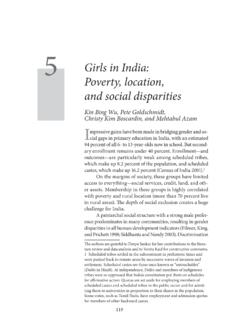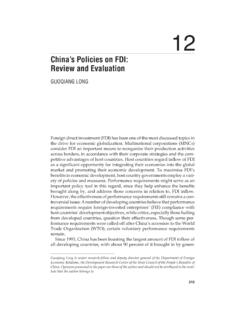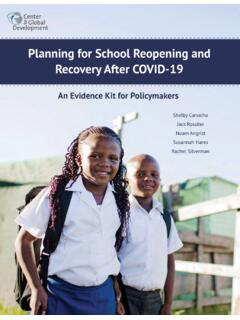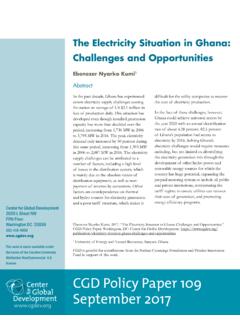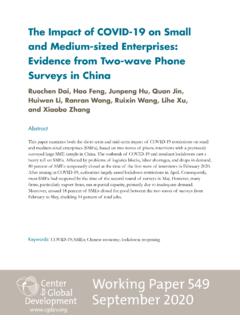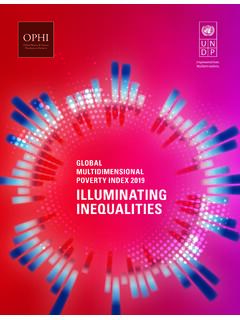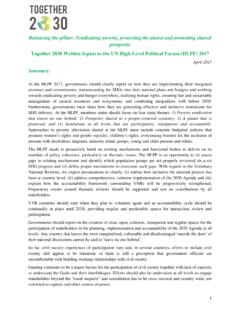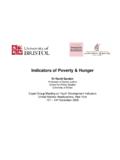Transcription of Global Trends in 2021 - Center for Global Development
1 1 Global Trends IN 2021: COVIDfl19 AND INTERNATIONAL DEVELOPMENTCGD NoteMAR 2021 This policy note was prepared at the request of Norwegian Ministry for Foreign Affairs in support of its Global Trends Initiative. The note is reprinted as a CGD note with the permission of the Norwegian Ministry for Foreign Affairs. All opinions are the authors alone. The authors are grateful to Mark Plant, Chief Operating Officer of CGD Europe and Director of Development Finance, and Rachael Calleja, CGD Senior Research Associate, for their comments and , overlaid on existing Global challenges, is the biggest stress test that international develop-ment cooperation has ever faced. The 2030 Agenda for Sustainable Development was billed as our common interest to ensure our common survival. That is no longer just an aspirational sentiment. Whilst no one can yet predict whether COVID-19 itself, as against the damage to economies and live-lihoods triggered by policy responses to it, will ultimately prove the bigger driver of the intervening excess deaths and other hardships, we can assume the indirect effect will dominate in many low-in-come countries and poorer communities over the long of the world is still in the midst of this searing COVID-19 experience, with its multidimensional domino effects.
2 Exceptional uncertainty surrounds what major features of our lives, livelihoods, and the Global order will change permanently or indeed already have changed. Yet a few basic contours of the new Global context are easier to trace than others, even if their specific consequences are still speculative. In this note, we review and overlay some of the features of the COVID crisis on earlier observed Trends and dynamics and explore some of the changes and Trends in Development agency strategic direction brought about by the pandemic. We end with three fundamental challenges that bilateral Development agencies will need to address, and which will define their Development coop-eration and international partnerships for the foreseeable NEW Global CONTEXTA Global economy in crisis with a projected unequal recoveryCOVID-19 has, with alarming speed, delivered a Global economic shock of enormous magnitude, leading to steep recessions in many countries.
3 It has had devastating effects on women, the young, the poor, people employed informally, and those working in contact-intensive sectors. Per capita in- Global Trends in 2021:How COVID-19 is Transforming International DevelopmentMikaela Gavas and Samuel Pleeck2 Global Trends IN 2021: COVIDfl19 AND INTERNATIONAL Development comes in the vast majority of emerging market and developing economies shrunk in 2020, tipping many millions back into poverty . The International Monetary Fund (IMF) estimates a percent contraction in Global GDP in 2020 the deepest Global recession since the Second World War. As a comparison, during the Global financial crisis in 2009, world economic output fell by just percent, although this number hides large differences between countries. Figure 1 compares the economic contraction as a result of the Great Lockdown in 2020 with the Global Financial Crisis in 1.
4 Comparative annual growth change, 2009 and 2020 Source: IMF DataMapper Tool (Retrieved on 24th February 2021) The pandemic has pushed Africa into its first recession in 25 years. In 2020, real GDP per capita is expected to contract by percent in sub-Saharan Africa, and by the end of 2021, it is likely to have regressed to its 2008 level. As a consequence, COVID-19 could push as many as 34 million people into extreme poverty in Africa, erasing at least five years of progress in fighting more effective infection control and vaccine deployment, the world economy is expected to re-cover in 2021. However, the speed and strength of the recovery will largely vary across regions de-pending on access to medical interventions, effectiveness of policy support, exposure to cross-country spill-overs, and structural characteristics of countries entering the crisis.
5 While China is forecasted to continue its rapid growth in 2021, Latin America and the Eurozone will lag We have also witnessed unprecedented peacetime surges in public debt during the pandemic. To lim-it long-term damage to the economy and facilitate the recovery, governments largely chose to pursue expansionist fiscal policies, hence creating budget deficits and increasing public debt. Following on an already-precarious situation before the pandemic, the debt-to-GDP ratio in developing countries 1 World Bank s Africa s Pulse Report (October 2020). 2 IMF World Economic Outlook (January 2021)3 Global Trends IN 2021: COVIDfl19 AND INTERNATIONAL DEVELOPMENTis expected to rise in the years ahead, increasing the threat to debt sustainability. In 2013, only 23 percent of the 69 low-income countries (LICs) analysed by the IMF were in debt distress or at risk of being in debt distress ; the percentage rose to 50 percent in 2019 and will likely be around two-thirds in These debt-related strains will add to broader social fractures around the unequal sharing of crisis and recovery burdens, by income group, occupation, region, age, gender, ethnicity, and geography.
6 Exposure to work-related health risks, and conversely, opportunities for distance work and distance learning, are heavily skewed in favour of older, better paid, better educated, and wealthier groups, and vice versa. Precarious gig-economy and informal workers in denser and substandard rented housing, with greater underlying health burdens, are also much more financially exposed to layoffs and less easily reached by public safety nets. This is especially true for internal or international mi-grant labourers, who can be victims of xenophobia and find no safe routes home. Steep declines in Global trade and financial flows to developing countriesCOVID-19 has led to steep declines in Global trade. The World Trade Organization (WTO) predicts a percent decline in the volume of Global trade in 2020. While trade in goods has seen a rapid recovery, trade in services is lagging. Once again, we observe different patterns by region.
7 Although Global ship-ping volumes now exceed pre-pandemic levels, this growth is being led by Services activity remains anaemic, weighed down by a continuing depression in tourism activity and international travel. Tourism arrivals fell by 72 percent in the first 10 months of 2020 and remain far below pre-pandemic levels. The Global health and economic crises have generated a steep contraction in all private financial flows to developing economies. The World Bank estimates remittance flows to low and middle income countries are expected to decline by percent to $508 billion in 2020, followed by a further decline of percent in 2021. The hit has been particularly severe in Central Asia, East Asia and sub-Saharan Africa, with declines between 9 percent and 16 percent in Estimates for the decline in foreign direct investment are even steeper at around 12 percent. And portfolio investment, the most volatile flow, is also forecasted to decline, posing a threat to the financial sustainability of companies in de-veloping See a policy paper by the IMF on the Evolution of Public Debt Vulnerabilities in Lower Income Economies.
8 4 From WTO Fall 2020 World Trade World Bank s Migration and Development Brief Trends IN 2021: COVIDfl19 AND INTERNATIONAL DEVELOPMENTF igure 2. Annual percentage change in private flows to low- and middle-income countries in 2020 Source: Remittances data from the World Bank s Migration and Development brief 33, FDI data from UNCTAD s Investment Trend Monitor (January 2021), and portfolio flows from the Institute for International Finance (IIF). IIF uses the following countries as a sample for emerg-ing markets: Argentina, Brazil, Chile, China, Colombia, Czech Republic, Hong Kong (China), Hungary, India, Indonesia, Israel, Malaysia, Mexico, Poland, the Republic of Korea, the Russian Federation, Saudi Arabia, Singapore, South Africa, Thailand, and Turkey. Reversed progress in Global poverty reduction and human developmentThe pandemic has wiped out years of progress in ending extreme poverty .
9 It is likely to push between 119 and 124 million people into extreme poverty in 2020, representing the first increase in extreme poverty since Some forecasters maintain that we can expect an additional 250 million people in extreme poverty by 2030 and that it will take 10 years of economic growth just to bring extreme poverty numbers back to where they were before the 3 shows that most of the new poor at the extreme poverty line, as well as at the higher poverty lines, live in South Asia. The World Bank estimates that 60 percent of people pushed into extreme poor by COVID will be in South Asia. This is followed by sub-Saharan Africa at the $ line and East Asia and Pacific at the $ line. At higher poverty lines, the regional distribution of the added poor changes markedly. Of the 225 million people expected to be pushed into poverty at the $ poverty line under the baseline scenario, two-thirds are in South Asia.
10 Of the 209 million expected to be pushed into poverty at $ , many newly poor are in East Asia and the Pacific, and few are in sub-Saharan Updated estimates of the impact of COVID-19 on Global poverty . See: Trends IN 2021: COVIDfl19 AND INTERNATIONAL DEVELOPMENTF igure 3. Regional distribution of COVID-induced poor in 2020 Source: Lakner et al. (2021)2020 also saw the first ever decline in the Human Development Index since it was introduced in 1990. UNESCO estimates that million children, adolescents, and youth are at risk of not returning to care centres, schools, or universities in 2020, the majority of whom live in sub-Saharan Africa and Amplified inequalities, including in gender and digital accessibilityCOVID-19 has amplified existing inequalities, in particular with those groups who are most vulnera-ble. The results of a recent Global survey of entrepreneurs sheds light on some of the gender disparities in the impact of COVID-19.

